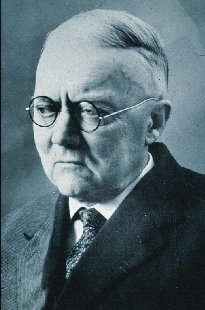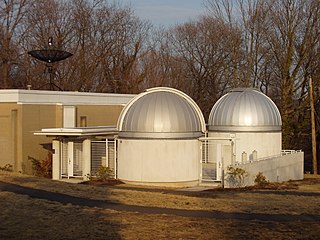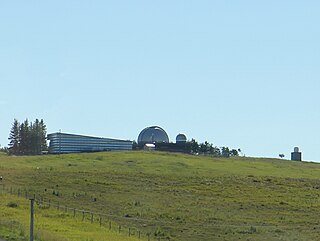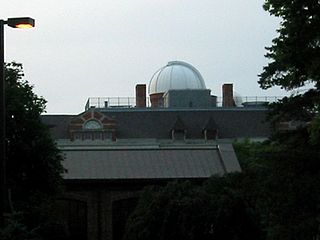
Lowell Observatory is an astronomical observatory in Flagstaff, Arizona, United States. Lowell Observatory was established in 1894, placing it among the oldest observatories in the United States, and was designated a National Historic Landmark in 1965. In 2011, the Observatory was named one of "The World's 100 Most Important Places" by TIME. It was at the Lowell Observatory that the dwarf planet Pluto was discovered in 1930 by Clyde Tombaugh.

The Jodrell Bank Observatory – originally the Jodrell Bank Experimental Station and from 1966 to 1999, the Nuffield Radio Astronomy Laboratories – hosts a number of radio telescopes, and is part of the Jodrell Bank Centre for Astrophysics at the University of Manchester. The observatory was established in 1945 by Bernard Lovell, a radio astronomer at the University of Manchester, to investigate cosmic rays after his work on radar during the Second World War. It has since played an important role in the research of meteoroids, quasars, pulsars, masers and gravitational lenses, and was heavily involved with the tracking of space probes at the start of the Space Age. The managing director of the observatory is Professor Simon Garrington.

Ernst Julius Öpik was an Estonian astronomer and astrophysicist who spent the second half of his career (1948–1981) at the Armagh Observatory in Northern Ireland.

The David Dunlap Observatory (DDO) is an astronomical observatory site just north of Toronto, in Richmond Hill, Ontario. Formerly owned and operated by the University of Toronto, from its establishment in 1935 until 2008; the observatory is now owned and operated by the City of Richmond Hill providing a combination of heritage preservation, unique recreation opportunities and a celebration of the astronomical history of the site. Its primary instrument is a 74-inch (1.88 m) reflector telescope, at one time the second-largest telescope in the world, and still the largest in Canada. Several other telescopes are also located at the site, which formerly also included a small radio telescope. The scientific legacy of the David Dunlap Observatory continues in the Dunlap Institute for Astronomy & Astrophysics, a research institute at the University of Toronto established in 2008.
The American Meteor Society, Ltd. (AMS) is a non-profit scientific organization established to encourage and support the research activities of both amateur and professional astronomers who are interested in the field of meteor astronomy. Its affiliates observe, monitor, collect data on, study, and report on meteors, meteor showers, meteoric fireballs, and related meteoric phenomena.

Sulphur Mountain Cosmic Ray Station, a National Historic Site of Canada found atop Sulphur Mountain in Banff National Park, commemorates Canada's participation in the International Geophysical Year, during 1957 to 1958. Canada constructed nine sites to study cosmic rays, but this site in particular was the most important due to its higher elevation. The National Research Council constructed a laboratory at the site in the winter of 1956–57. The building was not visible from the Banff townsite as a condition of its construction.

The Astronomical Observatory of Modra, also known as Modra Observatory or the Astronomical and Geophysical observatory in Modra, is an astronomical observatory located in Modra, Slovakia. It is owned and operated by the Comenius University in Bratislava. The scientific research at the observatory is led by the Department of Astronomy, Physics of the Earth and Meteorology, Faculty of Mathematics, Physics and Informatics.

Red Buttes Observatory (RBO) is an astronomical observatory owned and operated by University of Wyoming. It is located 15 kilometers (9 mi) south of Laramie, Wyoming (USA) and was founded in 1994. The observatory houses a 0.6 m (24 in) telescope built by DFM Engineering. There are two instruments available: a 1024x1024 imaging camera, and a near-infrared camera. A second, smaller telescope built by Orion is mounted on the main telescope. Research at the observatory has included monitoring Cepheid variable stars and follow-up observation of gamma-ray bursts.

Capilla Peak Observatory is an astronomical observatory owned and operated by the University of New Mexico (UNM). It is located in the Manzano Mountains of central New Mexico (USA), approximately 30 mi (48 km) southeast of Albuquerque. It has a 0.6 m (24 in) Cassegrain reflecting telescope built by Boller and Chivens and equipped with a CCD.

Fremont Peak Observatory (FPOA) is an astronomical observatory owned and operated by Fremont Peak Observatory Association. Built in 1986, it is located in Fremont Peak State Park, near San Juan Bautista, California. Fremont Peak Observatory houses the Challenger telescope.

The Yale University Observatory, also known as the Leitner Family Observatory and Planetarium, is an astronomical observatory owned and operated by Yale University, and maintained for student use. It is located in Farnham Memorial Gardens near the corner of Edwards and Prospect Streets, New Haven, Connecticut.

The Goodricke-Pigott Observatory is a private astronomical observatory in Tucson, Arizona. It was formally dedicated on October 26, 1996, and observations began that evening with imaging of Comet Hale–Bopp.

The Manastash Ridge Observatory (MRO) is an astronomical observatory built in 1972 by the University of Washington. It is located in a remote area approximately 14 kilometers (8.7 mi) west of Ellensburg, Washington, at an altitude of 3930', a longitude of 120.7278 degrees West, and a latitude of +46.9528 degrees, and can be reached by dirt roads from Ellensburg or Selah. The observatory features a 0.75 m (30 in) Ritchey-Chrétien telescope built by Boller and Chivens. Currently, the observatory utilizes an Andor thermo-electrically cooled CCD camera in conjunction with the primary telescope. Initially used for professional and graduate research, the observatory is now used mostly by undergraduate students for instruction and research. For a brief time there was talk of stopping funding for MRO as the University of Washington Astronomy Department focus on the Apache Point Observatory, but funding did continue and MRO is still in use.

The Israeli Astronomical Association (IAA) is an Israeli nonprofit organization. Its purpose is to deepen and distribute the awareness for the field of astronomy among the Israeli public.

Newbrook is a hamlet in central Alberta, Canada within Thorhild County. It is located at the junction of Highway 63 and Highway 661, approximately 28 kilometres (17 mi) northeast of Thorhild and 36 kilometres (22 mi) south of Boyle. It has an elevation of 665 metres (2,182 ft).

The Rothney Astrophysical Observatory (RAO) is an astronomical observatory located near the hamlet of Priddis, Alberta, Canada, about 25 kilometres (16 mi) southwest of Calgary. The observatory is owned and operated by the University of Calgary (UC), and was dedicated in 1972. The facility is used for research, undergraduate and graduate teaching, and public outreach. Research performed at the RAO included a variable star search program, follow-up observations of variable star discoveries, and detailed investigation of binary stars. An outstanding minor planet search program was also performed with comet discoveries by Rob Cardinal. The RAO now participates in many follow-up observation programs, including the Quark Nova project.

Sherzer Observatory is an astronomical observatory located on the campus of Eastern Michigan University. The observatory was established in 1903 with the construction of the new Natural Science Building, in Ypsilanti, Michigan. Following a devastating fire in 1989 a new observatory opened in September 1991 with a 10-inch (250 mm) apochromatic refractor telescope and German equatorial mount centered under a 6-meter dome.

The William Brydone Jack Observatory is a small astronomical observatory on the campus of the University of New Brunswick in Fredericton, New Brunswick. Constructed in 1851, it was the first astronomical observatory built in British North America. The observatory was designated a National Historic Site of Canada in 1954.

A public observatory is an astronomical observatory mainly dedicated to public and educational purposes. It is often supported by a municipality, a school or an astronomical society.

















